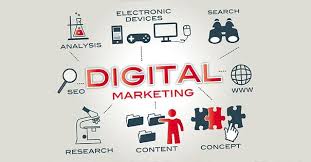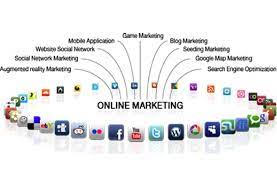Digital marketing has become an essential component of any successful business strategy. With the rise of technology and the increasing use of the internet, it’s no surprise that businesses are turning to digital marketing as a means to reach a wider audience and achieve their goals.
So what exactly is digital marketing? In simple terms, it refers to any form of marketing that utilizes digital channels such as search engines, social media platforms, email, and websites. The goal is to promote products or services through various online channels and connect with potential customers.
One of the most significant advantages of digital marketing is its ability to target specific audiences. With traditional forms of advertising like television or radio commercials, it’s challenging to determine who exactly is being reached. However, with digital marketing tools like Google Ads or Facebook Ads, businesses can target specific demographics such as age, gender, location, interests, and more.
Another advantage of digital marketing is its cost-effectiveness. Unlike traditional advertising methods that require a significant investment upfront, digital marketing allows businesses to set their budgets and only pay for results. For example, with pay-per-click (PPC) advertising campaigns on search engines or social media platforms like Facebook or Instagram, businesses only pay when someone clicks on their ad.
Furthermore, digital marketing offers measurable results. Through analytics tools like Google Analytics or Facebook Insights, businesses can track their campaigns’ performance in real-time. This allows them to make informed decisions about where to allocate their resources for maximum impact.
However, with so many different channels available for digital marketing today, it can be overwhelming for businesses to know where to start. That’s why it’s essential to have a well-defined strategy in place before launching any campaigns.
A successful digital marketing strategy should consider factors such as the target audience, budget constraints, goals and objectives, and the most effective channels for reaching those goals. It’s also crucial to continually monitor campaigns’ performance and adjust strategies accordingly based on data-driven insights.
In conclusion, digital marketing has become an integral part of modern business strategy. It offers a cost-effective way to reach specific audiences and provides measurable results. However, it’s essential to have a well-defined strategy in place and continually monitor campaign performance to achieve optimal results. By leveraging the power of digital marketing, businesses can connect with potential customers and achieve their goals in today’s digital landscape.
9 Essential Tips for Effective Digital Marketing
- Understand your target audience
- Create content that adds value
- Utilize SEO
- Take advantage of social media
- Track results
- Experiment with different channels
- Prioritize mobile users
- Develop a strategy
- Test & optimize
Understand your target audience
One of the most important tips for successful digital marketing is to understand your target audience. Knowing who your ideal customer is and what they want is crucial for creating effective marketing campaigns that resonate with them.
Understanding your target audience involves researching their demographics, interests, behaviors, and pain points. This information can be gathered through various means such as surveys, social media analytics, website analytics, and customer feedback.
By understanding your target audience, you can tailor your marketing messages to their specific needs and preferences. For example, if you’re targeting young adults interested in fitness and health, you might focus on social media platforms like Instagram or TikTok to showcase workouts and healthy recipes.
Moreover, understanding your target audience helps you choose the most effective digital marketing channels to reach them. If your target audience consists of professionals in a specific industry, LinkedIn might be the best platform to reach them with targeted ads or sponsored content.
In conclusion, understanding your target audience is a critical aspect of successful digital marketing. It allows you to tailor your messaging and choose the most effective channels to reach them. By taking the time to research and understand your ideal customer, you can create campaigns that resonate with them and achieve optimal results.
Create content that adds value
In the world of digital marketing, creating content that adds value to your audience is crucial for success. This means developing content that is informative, engaging, and relevant to your target audience.
Creating valuable content can help establish your brand as an authority in your industry and build trust with potential customers. By providing useful information or insights, you can position yourself as a thought leader and attract a loyal following.
Moreover, valuable content can also help improve your search engine rankings. Search engines like Google prioritize high-quality content that provides value to users. By creating content that answers common questions or addresses pain points for your target audience, you can increase the chances of appearing at the top of search results.
So how do you create content that adds value? Start by understanding your target audience’s needs and interests. What kind of information are they searching for? What problems are they trying to solve? Use this knowledge to develop content ideas that address these topics.
It’s also important to focus on quality over quantity. Don’t just create content for the sake of it – make sure each piece provides real value to your audience. This means taking the time to research and develop well-written articles, videos, or infographics that are informative and engaging.
Finally, don’t forget about promotion. Even the most valuable content won’t be effective if no one sees it. Use social media platforms like Facebook, Twitter, or LinkedIn to share your content with your followers and other relevant communities. You can also consider paid advertising options like Google Ads or Facebook Ads to reach a wider audience.
In summary, creating valuable content is essential for digital marketing success. By focusing on quality over quantity and understanding your target audience’s needs, you can establish yourself as an authority in your industry and attract a loyal following. Remember to promote your content effectively through social media platforms and paid advertising options for maximum impact.
Utilize SEO
Search engine optimization (SEO) is a crucial component of any digital marketing strategy. It involves optimizing your website and content to rank higher in search engine results pages (SERPs) for relevant keywords and phrases. By doing so, you can increase your website’s visibility and attract more organic traffic.
One of the most significant advantages of SEO is that it’s a long-term strategy that can yield lasting results. Unlike paid advertising, which stops generating traffic once the budget runs out, SEO efforts can continue to drive traffic to your site long after the initial work is done.
Another advantage of SEO is that it’s highly targeted. By optimizing for specific keywords and phrases, you can attract visitors who are actively searching for products or services like yours. This makes them more likely to convert into customers.
To utilize SEO effectively, it’s important to start with keyword research. This involves identifying the keywords and phrases that your target audience is searching for online. Once you have identified these keywords, you can optimize your website and content around them.
Some key areas to focus on when optimizing your website include title tags, meta descriptions, header tags, and image alt tags. Additionally, creating high-quality content that incorporates these keywords can help boost your rankings in search results.
While SEO may seem daunting at first, there are plenty of resources available to help you get started. From online guides and tutorials to professional SEO services, there are many options for businesses looking to improve their search engine rankings.
In conclusion, utilizing SEO as part of your digital marketing strategy can help increase your website’s visibility and attract more organic traffic over time. By focusing on keyword research and optimizing key areas of your website and content around those keywords, you can improve your chances of ranking higher in search engine results pages.
Take advantage of social media
Social media has become an integral part of our daily lives, and businesses have taken notice. With billions of people using social media platforms like Facebook, Instagram, Twitter, and LinkedIn, it’s no surprise that social media has become a crucial component of any successful digital marketing strategy.
One of the biggest advantages of social media is its ability to connect businesses with their target audience. By creating engaging content that resonates with their followers, businesses can build a loyal following and increase brand awareness. Social media also allows for two-way communication between businesses and their customers, which can help build trust and foster relationships.
Another advantage of social media is its cost-effectiveness. Unlike traditional advertising methods that require a significant investment upfront, social media allows businesses to reach their target audience without breaking the bank. With organic reach on the decline, many businesses are turning to paid advertising options on social media platforms to further expand their reach.
Social media also offers valuable insights into customer behavior through analytics tools like Facebook Insights or Twitter Analytics. This data can help businesses make informed decisions about where to allocate resources for maximum impact.
However, it’s essential to have a well-defined strategy in place before launching any social media campaigns. This includes identifying the target audience, setting goals and objectives, creating engaging content that resonates with followers, and measuring campaign performance through analytics tools.
In conclusion, taking advantage of social media can be a game-changer for businesses looking to expand their reach and connect with potential customers. By creating engaging content that resonates with followers and leveraging the power of paid advertising options on social media platforms, businesses can achieve remarkable results in today’s digital landscape. However, it’s essential to have a well-defined strategy in place and continually monitor campaign performance to achieve optimal results.
Track results
One of the most important tips for successful digital marketing is to track results. Digital marketing offers a wealth of data and insights that can help businesses make informed decisions about their campaigns. By tracking results, businesses can determine which strategies are working and which ones need to be adjusted.
There are many ways to track results in digital marketing, including analytics tools like Google Analytics or Facebook Insights. These tools allow businesses to monitor website traffic, engagement rates, conversion rates, and more. By analyzing this data, businesses can identify patterns and trends that can inform future campaigns.
Tracking results also allows businesses to measure return on investment (ROI). By comparing the cost of a campaign with the revenue generated from it, businesses can determine if their efforts are producing positive results. This information is crucial for making informed decisions about where to allocate resources in the future.
In addition to tracking results for individual campaigns, it’s essential to monitor overall performance over time. This helps businesses identify long-term trends and adjust strategies accordingly. For example, if website traffic is consistently declining over several months, it may be time to reevaluate the website’s design or content strategy.
Overall, tracking results is an essential component of successful digital marketing. It provides valuable insights into campaign performance and allows businesses to make data-driven decisions about their strategies. By leveraging the power of analytics tools and continually monitoring performance, businesses can optimize their digital marketing efforts and achieve their goals in today’s digital landscape.
Experiment with different channels
When it comes to digital marketing, it’s important to remember that there is no one-size-fits-all approach. What works for one business may not work for another. That’s why it’s essential to experiment with different channels to find what works best for your brand.
There are many different channels available for digital marketing, including search engine optimization (SEO), pay-per-click (PPC) advertising, social media marketing, email marketing, and content marketing. Each channel has its strengths and weaknesses, and it’s essential to understand how they can fit into your overall strategy.
Experimenting with different channels can help you identify which ones are most effective in reaching your target audience and achieving your goals. For example, if you’re looking to increase brand awareness, social media marketing may be the best option. On the other hand, if you’re looking to drive sales or leads quickly, PPC advertising may be a better choice.
It’s also important to note that each channel requires a different approach and level of expertise. For example, SEO requires a deep understanding of search algorithms and keyword research, while content marketing requires strong writing skills and the ability to create engaging content.
By experimenting with different channels, you can gain valuable insights into what resonates with your audience and how you can optimize your campaigns for maximum impact. Don’t be afraid to try new things and take risks – sometimes the most successful campaigns come from unexpected places.
In conclusion, experimenting with different channels is a crucial part of any successful digital marketing strategy. By trying new things and analyzing the results, you can identify which channels work best for your business and achieve optimal results in today’s competitive digital landscape.
Prioritize mobile users
In today’s digital age, it’s more important than ever to prioritize mobile users in your digital marketing strategy. With the majority of internet traffic now coming from mobile devices, businesses that fail to optimize their content for mobile risk losing out on a significant portion of potential customers.
One way to prioritize mobile users is by ensuring that your website is mobile-friendly. This means that it should be designed to be easily navigable on smaller screens and load quickly on mobile networks. A responsive design that adjusts automatically to different screen sizes is also essential.
Another way to cater to mobile users is by optimizing your content for mobile consumption. This means using shorter paragraphs, larger fonts, and concise language that gets straight to the point. Visual content like images and videos can also be effective in engaging mobile users.
Additionally, businesses should consider prioritizing mobile-friendly channels like social media platforms and messaging apps in their digital marketing efforts. These channels are often used more frequently on mobile devices than desktops and can provide a direct line of communication with potential customers.
By prioritizing mobile users in your digital marketing strategy, you’ll be able to reach a wider audience and connect with potential customers where they spend most of their time – on their smartphones. Don’t miss out on the opportunity to engage with this growing demographic – make sure your digital marketing efforts are optimized for mobile today.
Develop a strategy
Developing a strategy is a crucial tip for any successful digital marketing campaign. Without a well-defined plan in place, businesses risk wasting resources and missing out on valuable opportunities to connect with their target audience.
A successful digital marketing strategy should consider various factors such as the target audience, budget constraints, goals and objectives, and the most effective channels for reaching those goals. By understanding these key elements, businesses can create a roadmap that outlines how to achieve their desired outcomes effectively.
One of the benefits of developing a strategy is that it provides clarity and direction. It allows businesses to focus their efforts on specific areas that are most likely to yield results. By identifying the most effective channels for reaching their target audience, businesses can allocate resources more efficiently and maximize their return on investment.
Another advantage of developing a strategy is that it helps businesses stay ahead of the competition. With so many companies vying for attention in today’s crowded digital landscape, having a well-defined plan can give businesses an edge over competitors who may be less organized or focused.
Finally, developing a strategy allows businesses to measure success accurately. By setting clear goals and objectives from the outset, it becomes easier to track progress and adjust strategies accordingly based on data-driven insights.
In conclusion, developing a strategy is an essential tip for any successful digital marketing campaign. It provides clarity and direction while helping businesses stay ahead of the competition. By identifying key elements such as target audience, budget constraints, goals and objectives, and effective channels for reaching those goals, businesses can create a roadmap that maximizes their chances of success in today’s digital landscape.
Test & optimize
One of the most important tips for successful digital marketing is to test and optimize your campaigns continually. With so many different channels available for digital marketing, it can be challenging to determine which ones are most effective for your business.
That’s why it’s essential to test different strategies and tactics to see what works best for you. For example, if you’re running a Facebook Ads campaign, try testing different ad formats, targeting options, and messaging to see which combination yields the best results.
Once you’ve identified what works best, it’s crucial to optimize your campaigns continually. This involves analyzing data and making adjustments based on insights gained from that data. For example, if you notice that certain keywords are driving more traffic to your website than others, you may want to adjust your PPC campaigns’ bidding strategy accordingly.
By continually testing and optimizing your digital marketing campaigns, you can ensure that you’re getting the most out of your investment. It allows you to identify areas for improvement and make data-driven decisions about how to allocate resources for maximum impact.
In conclusion, testing and optimizing should be an ongoing process in any digital marketing strategy. By continually analyzing data and making adjustments based on insights gained from that data, businesses can achieve optimal results in today’s competitive digital landscape.





